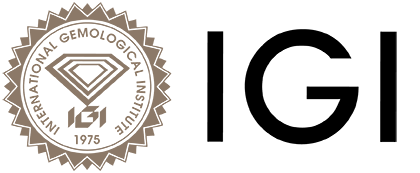When it comes to buying a diamond, one of the most important factors to consider is its grading and certification. Two of the most renowned and widely recognized grading laboratories in the industry are IGI (International Gemological Institute) and GIA (Gemological Institute of America). Both institutions play a crucial role in determining the quality and value of diamonds.
In this blog, we will delve into the differences and similarities between IGI and GIA diamond grading and certification. By understanding the distinctions between these two organizations, you will be better equipped to make an informed decision when purchasing a diamond and ensure you get the quality you desire.
International Gemological Institute
International Gemological Institute (IGI) is a diamond grading, colored stone, and jewellery certification organization. IGI is headquartered in Antwerp and has offices in New York City, Hong Kong, Mumbai, Bangkok, Tokyo, Dubai, Tel Aviv, Toronto, Los Angeles, Kolkata, New Delhi, and Surat, Chennai, Thrissur, Ahmedabad, Shanghai, and Cavalese. Established in 1975, IGI is the largest independent gemological laboratory worldwide. It also runs Schools of Gemology in several locations around the globe.
IGI screens every diamond using state-of-the-art technologies to determine naturally mined, laboratory-grown, or simulant origin. Experienced graduate gemologists conduct a further assessment in controlled conditions, detailing relevant gemological characteristics according to the strictest international system. Renowned for diamonds and colored gemstones, we are equally trusted with the grading of pearls, exotic carvings, fine jewellery pieces, and modern synthetics and simulants.
Gemological Institute of America
GIA (Gemological Institute of America) is the world’s foremost authority on diamonds, colored stones, and pearls. A public benefit, nonprofit institution, GIA is the leading source of knowledge, standards, and education in gems and jewellery.
Across the world, people honor and appreciate the beauty and mystery of gems. Just like the gems being at the heart of this work, the opportunities are infinite, limited only by one’s imagination, passion, and the professional skills they need to take one there. GIA’s Career Services brings together employers offering career opportunities, and its professionally trained students and alumni, ranging in experience from entry-level to seasoned management.
It has shaped the gem industry, protected millions of consumers, and taught generations of jewelers and GIA gemologists all over the world since 1931. Through research, education, and unbiased gem grading and analysis, GIA strives to protect the gem and jewelry buying public by setting global quality standards. Comprising over 3,000 employees in 13 countries, GIA is a place of diversity, innovation, creativity, and engagement.
GIA is one of the best grading labs in the world, often consistent in grading diamonds, and is a standard-bearer for diamond certification and grading in the diamond industry. The International Gemological Institute, or IGI, is also a vast institution and has been around since 1975.
IGI is Improving but is still not on par with GIA
While both the GIA and the IGI are reputable labs, there are noticeable differences in grading diamonds. In a nutshell, the IGI is not as consistent or strict in grading diamonds as the GIA. Therefore, if you are considering an IGI graded diamond, read the tips carefully to avoid making obvious mistakes and know what you are in for.
What is the main difference between IGI and GIA?
In Europe and Asia, IGI’s grading reports are widespread. However, the GIA has been gaining more market share in recent years. In the US, the GIA is by far the first go-to lab. In our opinion, the IGI is not as strict as the GIA when grading diamonds, but it does not mean that one should entirely rule them out.
The Difference between IGI and GIA in Diamond grading the 4Cs:
Because the IGI is loosely structured globally, slight inconsistencies among its labs may exist, depending on their location.
As a rule of thumb, it is safe to assume a 1-grade color inconsistency in D-I color diamonds between GIA and IGI graded diamonds. This inconsistency is much more minor for lower color range diamonds. One can also expect a 1-grade clarity inconsistency in IGI and GIA graded diamonds, especially in high investment-grade diamonds with D-F color and flawless to VVS clarity range.
On the bright side, around 10-20% of IGI-graded diamonds might be consistent with how the GIA would grade them. Human beings grade diamonds; individual gemologists grade and then cross-examine them. Therefore, some gemologists in the IGI may be as strict as those in the GIA. The drawback is the lack of same consistency in grading diamonds across the organization as the GIA.
Types of reports to look for while buying IGI and GIA Diamond graded:
Gemstones should only change hands when accompanied by a grading report attesting to quality. Regardless of location or marketplace, an authentic IGI Laboratory Report is the common language of trust and confidence in the gemological world.
The GIA has diamond dossiers (generally for small diamonds) and complete grading reports for any size diamond. The IGI has two diamond grading reports: mini-reports and complete grading reports. Unlike GIA dossiers with sufficient information on them, IGI’s mini grading reports, often issued to vendors in shopping malls, are notoriously limited in their facts, especially about the cut of a diamond. If you are buying an IGI-graded diamond, make sure you buy a diamond with a full IGI report issued by one of their well-established labs in the U.S. or Antwerp.
IGI certification diamond
IGI Diamond Reports give an accurate assessment of a diamond’s cut, color, clarity, and carat weight according to strict international standards.
GIA diamond certification
GIA diamond is a term you’ll find when engagement ring shopping – short for a diamond graded by GIA, the creator of the 4Cs and the independent, diamond authority. It is an independent, non-profit organization that conducts gem research, educates gem professionals, and sets the standards for determining diamond quality.
GIA diamond certification is highly regarded worldwide due to its rigorous grading process and adherence to strict standards. Each diamond undergoes a comprehensive assessment by a team of highly skilled gemologists who evaluate the stone’s cut, color, clarity, and carat weight. These experts use state-of-the-art equipment and techniques to ensure accuracy and consistency in their assessments.
The certification provided by GIA includes a detailed report that contains essential information about the diamond’s characteristics. This report serves as an unbiased and reliable reference for buyers, jewelers, and appraisers. It provides valuable insights into the diamond’s quality, enabling consumers to make informed decisions when purchasing or selling diamonds.
One of the key advantages of GIA diamond certification is its consistency and integrity. GIA’s grading standards are widely recognized and respected, ensuring that consumers receive accurate and reliable information about the diamonds they are considering. Additionally, GIA’s extensive research and education efforts contribute to the continuous improvement of diamond grading practices and industry knowledge.
IGI Diamond Grading Report
The IGI Diamond Grading Report gives an accurate assessment of a diamond’s cut, color, clarity, and carat weight according to strict international standards.
- Offered in different formats to serve consumer needs across diverse worldwide markets
- Every report is issued according to the strict international standards and security features for which IGI is known
- IGI grades the widest variety of gemstones and jewellery across the world than any other gemological organization
The report includes essential information about the diamond, such as its carat weight, color grade, clarity grade, cut grade, and shape. These factors play a crucial role in determining the value and quality of a diamond. The IGI uses internationally recognized standards and state-of-the-art technology to evaluate each diamond accurately.
One of the key aspects of the IGI Diamond Grading Report is its clarity grading. This assesses the presence of internal or external flaws, known as inclusions and blemishes, respectively. The report provides a detailed description of these characteristics, enabling buyers to make an informed decision.
The IGI Diamond Grading Report also evaluates the diamond’s color grade. This rating is based on the absence of any noticeable color in the stone. The report uses a scale ranging from D (colorless) to Z (light yellow or brown).
Furthermore, the report assesses the diamond’s cut grade, which determines its brilliance and overall appearance. The IGI evaluates factors such as proportions, symmetry, and polish to provide an accurate rating.
Overall, the IGI Diamond Grading Report serves as an essential tool for both buyers and sellers in the diamond industry. It provides transparent and reliable information that helps ensure confidence in the quality and value of a diamond.
GIA Diamond Grading Report
The GIA Diamond Grading Report includes an assessment of a diamond’s 4Cs – color, clarity, cut, and carat weight – along with
- A plotted diagram of its clarity characteristics and a graphic representation of the diamond’s proportions
- GIA Cut grade for standard round brilliant cut diamonds falling in the D-to-Z color range that weigh 0.15 carats
- GIA Diamond Grading Reports are not issued for laboratory-grown, diamond simulants, mounted designs, or those that have undergone unstable treatments, such as fracture filling or coating
The reports issued by the IGI for lab-grown diamonds are stricter and more accurate than their reports for naturally mined ones.
Final Thoughts
When comparing IGI and GIA diamond grading and certification, it is important to consider several factors. Both organizations are reputable and recognized in the diamond industry, but there are some differences. GIA is known for its strict grading standards and consistent results, providing a higher level of confidence for buyers.
On the other hand, IGI offers a faster turnaround time and lower cost for grading services. Ultimately, the choice between IGI and GIA depends on individual preferences and priorities. It is recommended to research and understand the specific needs and requirements before making a decision.






